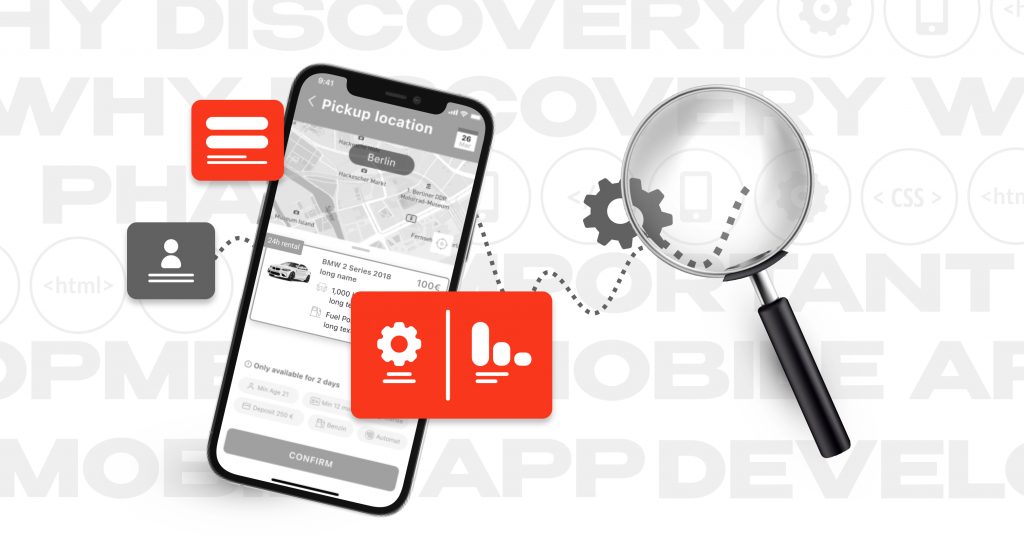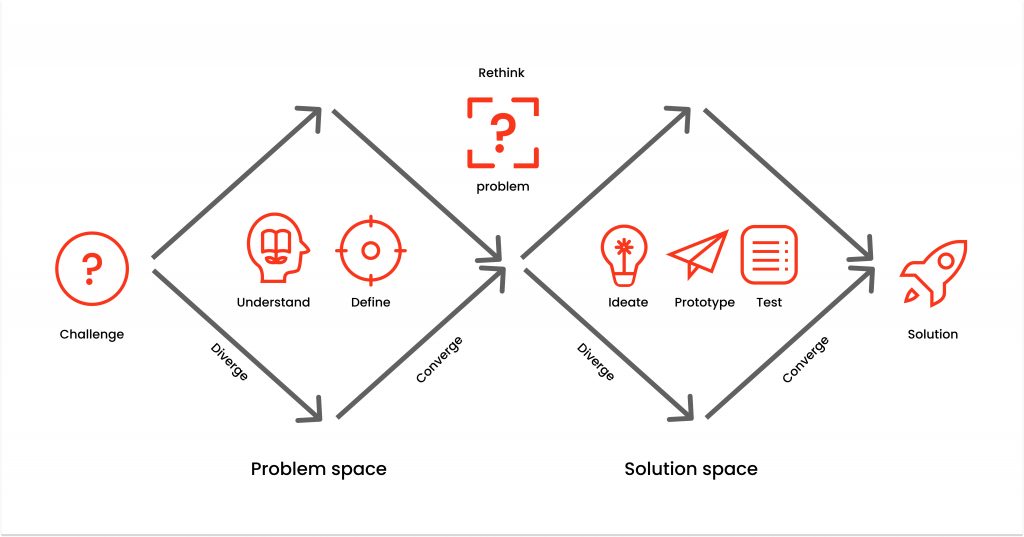Why Product Discovery Phase is Important in Mobile App Development?

What is a Product Discovery phase? What role does Product Discovery play in mobile app development and what does the Product Discovery process look like? Why do I have to do it? These are some common questions we get from our clients. Read this article to learn why the discovery phase is instrumental in mobile app development and how it helps to save time and money while preparing your mobile project for the big launch.
What is the discovery phase in development?
Product Discovery in app development projects is the preliminary stage of the development journey. This step is essential for making sure you know who your target buyers are and that your app will satisfy the customer’s needs in the market. It will also help determine the core features of the app you’re planning to build.
The goal of the Product Discovery process is to prepare for the development stage in the best possible manner through constant testing of ideas and solutions to learn about your end-user’s needs.
You might ask – why not just start developing right away? The truth is Product Discovery is an optional process, however, it is absolutely intrinsical for projects that require big-budget, costly development. Without research, the project is bound to get more expensive and lengthy due to iterations and changes.
One of the things that we learned through years of experience is that prevention is cheaper than correction, and correction is cheaper than failure. Precaution helps avoid constant adjustments and changes which turn into additional expenses and frustration. The Product Discovery process will eventually cost you next to nothing compared to the consequences of releasing a useless, unpopular application.
To sum up, with Product Discovery our team focuses on making sure we are about to build something that will be in demand and start development with certainty.
How does the Product Discovery process look like?
Each company will have a different Product Discovery process. It obviously has to be tailored to the specific business needs of the client. Some need 1 week, some need 1 month to solidify the business strategy.
Let’s go over the essential areas we focus on during Product Discovery:
- Establishing goals
What is my goal? What result do I want to achieve? - Research
Who is the end-user? Describe potential users and their problems. What kind of problems do they experience? How can I help them? - Brainstorming solutions
How can I solve the problem? What will be the outcome? What is the best solution? - Prototyping
What is my user’s experience? Do I find the solution convenient? - Reviewing ideas
Are my ideas good enough? What do my users think about them? Can I really solve their problems? - Finalizing
Which ideas are we going to implement? - Prioritization
What are the features to be implemented first? - Planning for development
What is the scope of the MVP (Minimum Viable Product)?
Product Discovery Steps
Now let’s examine each step in more detail. Keep in mind that the whole process has a structure and it’s essential to go from one step to another without skipping.
Establishing goals
Product discovery involves many stakeholders and establishing goals across all levels at this early stage is essential. Here stakeholders should concentrate on defining a user problem and giving enough context for the team to examine it.
Here, it is very important to focus on the problem instead of coming up with solutions. So, the task of a product manager is to build a process in a way where all stakeholders describe the problems they see rather than interpret them and offer solutions (for example, offer to include specific features, use certain tools, etc.).

Research
The biggest task at this stage is to research the product opportunity. We have to know the struggles our potential users have and identify the problems the product will solve. For the problem definition, it’s better to come up with a short description to nail down the issue.
To improve control and visibility, you can break research into categories.
| Research categories | |
| Behavior | What people do |
| Attitude | What people say |
| Quality | Direct observations |
| Quantity | Indirect sampling of reality |
Remember that you should ask the focus group the questions that will help you get the most accurate answers. If you’d like to learn more about the art of posing the right questions, check out The Mom Test book by Rob Fitzpatrick.
Brainstorming solutions
Once the problems are defined, the team can start ideating on how to solve these problems. There are several forms of ideation that include classic brainstorming, mind mapping, and storyboarding. The more ideas are proposed, the better. People can work independently and then gather to discuss and prioritize the best suggestions. In the final step, the team members can vote.
Reviewing, Finalizing & Prioritization
This is the validation phase where stakeholders decide on the ideas that will be implemented. Can we go ahead and spend time and resources on the solution? At this stage, we make sure that our solution can effectively solve the most essential user problems. Keep in mind that when you validate your project, you might not be able to test on multiple users, so the final results should be carefully analyzed and only the data with maximum insights should be relied on.
Planning for development
When you have validated certain ideas, you can start turning them into an MVP (Minimum Viable Product). So at this stage, you have everything to move from the product discovery phase results to the actual product delivery. Now it’s time to fill the task backlog, prioritize, and set release timelines.

How Does Product Discovery Relate to Product Delivery?
It is important to understand that Product Discovery is a continuous process in companies with a product team or companies that plan to develop their own product team. If you want to grow a customer-centric organization, you will have to consistently turn to user feedback and seek insights.
In Product Discovery and Product Delivery teams can apply Agile principles and most of the time they do. The activities of Delivery and Discovery often go together as both are continuous activities that have iterations.

However, when your product is not yet built, the Product Discovery phase comes first. The Product Discovery results heavily influence Delivery, even though some activities may happen in parallel.
Does every mobile app project need a Product Discovery phase?
Actually, every app needs a solid Product Discovery Phase and since it’s a continuous process, you will come back to it at one point. However, if you conducted an extensive research and already know that you will most definitely fill the gap in the market and have a very good understanding of your potential customers, then you are in luck and can move on to product development.
The most costly mistakes are those that impact the development process when it’s already in progress and result in delays and expensive changes. The Product discovery phase helps eliminate the risks and help you make sure that your features will be in demand, your app design will work well for your customers, and the benefits you offer will resonate with your target audience.
Who should participate in Product Discovery?
Creating a valuable product is not an easy feat. When we help our clients with building a new application, we iinvovle the work of those who are the most competent people in the Product Discovery phase. The size of the team depends on the complexity of the app.
- Technical: Developers with specific expertise (iOS, Android, Backend, QA)
- Business: Business Analyst
- Design: UX/UI Designers
- Process: Scrum Master/Agile Coach, Project Manager
- Stakeholders: Product Manager, Investor, Delivery Manager
- Target users
This variety ensures that you get experts to provide a hollistic perspective and valuable feedback on the ideas you want to bring into life.
What do I get as the result of the Discovery Phase with Ein-des-ein?
We believe that well-defined and described requirements are essential for the successful project delivery. That’s why we focus on the discovery phase, which leads to the creation of detailed specifications that include:
- low fidelity prototype of the solution,
- complete list of user stories or features to be included into the MVP version,
- description of the solution’s architecture and technologies to be applied,
- software development roadmap,
- time and budget estimation for the MVP version.
Conclusion
Does every mobile app project need a Product Discovery phase? Absolutely.
You can do it internally or our team at Ein-des-ein can help you. We’ve worked with many companies and teams that went on to successfully present the MVP to investors and get more money to continue building their products. We’ve also helped many build product from the MVP to a full-fledged solutions that work today. If you want to talk to us and need a free consultation, please reach out to us. Click on the banner below or write directly to contact@ein-des-ein.com. We can’t wait to hear from you!
